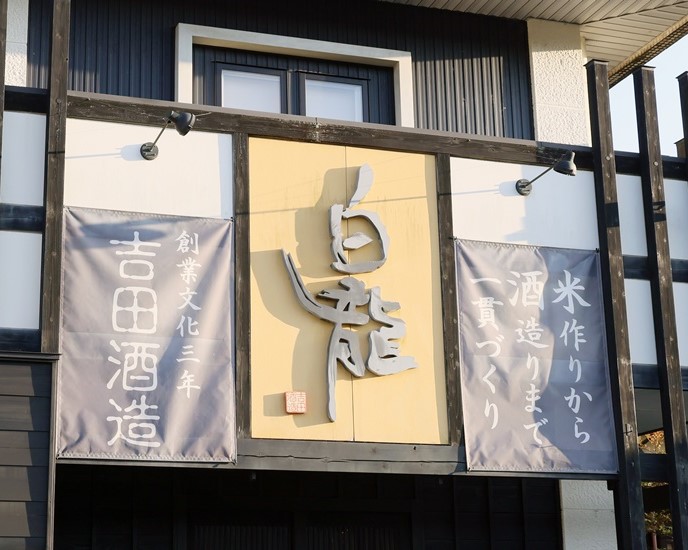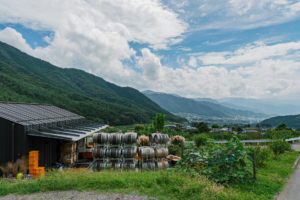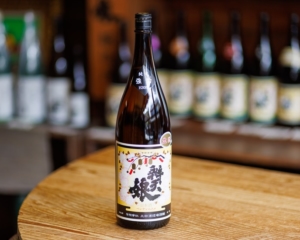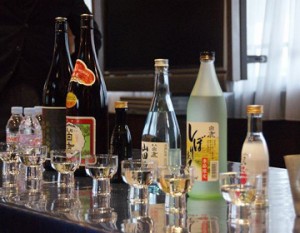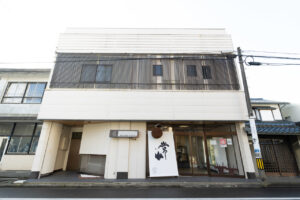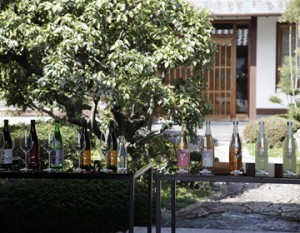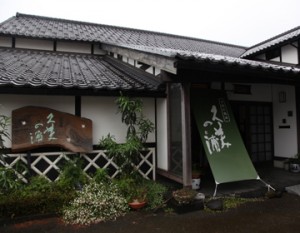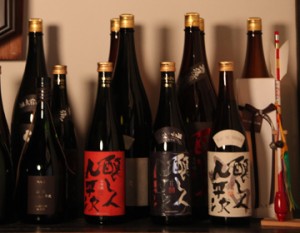Founded in 1806, Yoshida Sake Brewery is located in Eiheiji-cho, Yoshida-gun, Fukui Prefecture. The high-quality sake rice and abundant water of Eiheiji-cho, as well as the local people and climate, are all described as “terroir,” and the sake brewed here opens the door to a new world for this long-established sake brewery.
Predecessor Makes a Splendid Comeback in Rice Cultivation

Yoshida Shuzo, which has brewed the famous sake Hakuryu, is located near the majestic Kuzuryu River. The area has an abundance of high-quality water suitable for sake brewing and rice cultivation, and the town of Eiheiji is home to a concentration of nationally known sake breweries, including the Koryu Brewery (which produces Koryu) and the Tanabe Brewery (which produces Echizenmisaki). In this fierce competition, Yoshida Mako is the toji at Yoshida Sake Brewery, and in 2017, at the young age of 25, she became the toji, garnering much attention as the youngest female toji in Japan at the time.
She now runs the brewery with her mother, Yukari, her sister, Shoko, and her husband, Daiki.
Junmai sake brewed entirely with rice grown in Eiheiji Town

Yoshida Sake Brewery became a pure rice sake brewery in 2017 when Mako-san became the toji. The sake rice used is Yamadanishiki, Gohyakumangoku, and Hanaechizen, and starting in 2018, all of the rice used as ingredients is produced in Eiheiji-cho.
Mako’s goal is to create a sake that is as pure and clear as the local water, and that can be enjoyed as a “sake to be enjoyed with food” while taking advantage of the characteristics of the Eiheiji rice.
New brewery to produce sake for foreign markets
In 2023, Yoshida Shuzo will build a new brewery and begin brewing a new type of sake for the overseas market that does not rely on junmai, ginjo, or other sake with a specific name. The driving force behind this small, family-run brewery’s global challenge is the passion for sake brewing that Mako’s father, Tomohiko, the sixth-generation brewer who passed away eight years ago, bequeathed to his family.
Breaking away from the grading system of sake brewing
When Tomohiko took over Yoshida Shuzo in the 1980s, the sake produced was mainly first- and second-grade sake. First- and second-grade sake were once the designations in the sake grading system, which was abolished in 1992 and replaced by the “Tokutei Meishu” system of junmai and ginjo sake.
At a meeting at the Takinogawa Brewery Experiment Station, where Tomohiko once trained as a sake brewer, he had the opportunity to drink sake collected from all over Japan. The first sake to be emptied was a daiginjo made from polished Yamada-Nishiki, which was a favorite of the participants. Witnessing this scene, Tomohiko felt that there was no future for him if he continued to rely on first- and second-class sake, and he decided to brew sake using Yamada Nishiki.
If you can’t buy rice, grow your own.

In 1990, Tomohiko attempted to purchase Yamada-Nishiki from the sake brewers association, but was turned down because of his lack of experience. While he was struggling, an acquaintance suggested that he grow his own Yamada-Nishiki, and he thought, “I see. At the time, the Yoshida family owned a number of rice fields that produced Koshihikari for food, and Tomohiko immediately set out to cultivate Yamada-Nishiki in Fukui, which at the time was considered the northern limit of cultivation.
Sake brewing starts with soil preparation
While chemical fertilizers were used in the fields where Koshihikari had been grown, no such fertilizers were used in the cultivation of Yamada-Nishiki, and pesticides were used as little as possible. As a result, only 3 bales of rice were harvested per 1 tan of rice field in the first year. Since it is said that a typical edible rice crop yields about 8 to 10 bales per one-tenth of a rice field, the yield was about one-third of the normal yield. However, the brewers were happy to have successfully harvested the rice for sake, and they began to make sake on a trial basis. Since they were now able to handle the entire process from rice cultivation to sake production, they decided to make a special junmai sake and junmai ginjo sake. The resulting sake was deeply moving, and seemed to indicate the path the company should take in the future.
Three years after they began cultivating Yamada-Nishiki, they were finally able to harvest a certain amount of Yamada-Nishiki of consistent quality.
Pursuit of quality, not quantity
In 2006, Tomohiko revived a sake called “Asaizumi,” which had been recorded from the time of the brewery’s founding, and released “Hakuryu Junmai Kaiso-shu Asaizumi” as a commemorative sake for the 200th anniversary of the brewery. The Yamada-Nishiki rice is polished to a low polishing ratio of 85% to recreate the flavor of the rice that would have been drunk in ancient times. The brewery also worked to produce high-end sake such as Junmai Daiginjo, which is made from large-grain Yamada-Nishiki. Although the management of the brewery itself was still in a very difficult situation, the direction for the future was gradually becoming clear.
The Family’s Challenge to Succeed the Will of the Predecessor

Some time later, in June 2014, Mako, who was about to graduate from college, received a call from Yukari. Tomohiko-san’s health is not good, and we are short on staff. Tomohiko is not feeling well and we are short on staff. Mako was so excited that she decided to ask him for help. So in the spring of 2015, after graduating from college, Mako immediately entered the brewery and began helping out with the brewing. However, at the end of that year, Tomohiko passed away at the young age of 54. The following year, the veteran Nanbu Touji, who had been asked to help out, suffered a back injury and returned to his hometown due to his advanced age. These difficulties combined to plunge the brewery into an unprecedented crisis.
Mothers and Daughters Survive the Crisis
Without a toji (master brewer), Yoshida Sake Brewery began brewing sake in 2016. Mako-san had some knowledge, but almost no experience. She sent daily updates on the progress of the unrefined sake to the Food Processing Research Institute, a prefectural agency, and received advice from visits to the brewery, and managed to get through that year, but the question of what to do with the sake from now on was a big one that kept going around in her mind. After Tomohiko’s death, Yukari, the seventh generation to take over the brewery, said to Mako, “You have helped with the brewing for the past two years and have a good understanding of the brewery’s policies. I want you to be the toji (master brewer). However, despite a month and a half of training at the Institute for Sake Research, which organizes the National New Sake Competition, analyzes and appraises sake, and provides training for brewers, Mako was not yet in a position where she could proudly say that she was proficient in sake brewing, which caused her great anxiety. She even thought about quitting the brewery. At that time, the secretariat of a local sake cooperative with which her father had a close relationship approached her about participating in a summer trial brewing program at the Kamikawa Taisetsu Sake Brewery in Hokkaido.
Yoshida Brewery, where the family comes together as one

In 2017, Mako’s mindset changed as she learned sake brewing from the ground up under Shinji Kawabata, the toji at Kamikawa Taisetsu Sake Brewery. Until then, she had been thinking only of “just perfecting sake,” but with Mr. Kawabata’s experienced instruction, she gradually came to understand the fun and depth of sake brewing, and she began to feel a desire to “make sake that I can truly enjoy.
After completing her training, Mako decided to officially become a toji. The following year, in 2018, her sister Shoko, who was working for an IT company in Tokyo, married Daiki, and the couple joined Yoshida Sake Brewery to help the company. Sachiko used the knowledge and experience she gained at the IT company to modernize the brewery, while Daiki assumed responsibility for sake rice cultivation. A structure is now in place to further refine the high-quality sake brewing that their late father laid the foundation for.
Established a joint venture with a Hong Kong company
After the death of her father, Yoshida Shuzo expanded the Yamada-Nishiki fields left to her by her father and improved the brewing facilities to further enhance the quality of the sake. Mako has also improved her brewing techniques as the years have passed, and is steadily approaching her longtime goal of producing a clear sake with no cloying taste, yet with a strong sense of rice flavor. Junmai Daiginjo” won a gold medal for two consecutive years at the National New Sake Competition in 2021 and 2022, and in recent years its reputation has become firmly established.
In June 2022, Yoshida Shuzo embarked on a major challenge. The company established Symphony Yoshida Brewery Co., Ltd. as a joint venture with Symphony, a Hong Kong-listed company that had been considering global expansion of sake production, to brew sake for the overseas market. With a focus on Hong Kong, Singapore, and other Asian countries, the company aims to enhance the value of sake and develop the global market through thorough quality control.
Also, in 2023, the Yoshimine Baian (Yoshimine Brewery), a renovated 100-year-old private house, will be completed. At this facility, through workshops to introduce the attractiveness of Eiheiji-machi sake rice, cedar ball making workshops, and other experiences, the charms of the culture and climate of Eiheiji-machi will be communicated, which can be learned only from a sake brewery that has taken root in this region and has been brewing sake.

Eiheiji Brand to the World
Thus, the Yoshida Sake Brewery began to promote the excellence of “Eiheiji Terroir” to the world. The company does not use a specific name for its overseas sake, which expresses the terroir, and instead plans to use the full potential of the sake rice, mainly Yamada-Nishiki grown by the company and its contract farmers, to create a sake with the best possible quality. In order to achieve this goal, they will need to increase the production of high-quality sake rice, but they expect to be able to meet this challenge thanks to the participation of farmers in Eiheiji Town, with whom they have developed close ties through workshops on the growth of Yamada Nishiki held by Daiki, who is in charge of rice production, in the Yoshida Sake Brewery Group’s sake rice production.
Mako says, “I am anxious about how our sake, which expresses the Eiheiji terroir, will be accepted overseas, but my expectations outweigh that. The challenge of going overseas has just begun, but as the sake brewed by the Yoshida Sake Brewery Group gains recognition overseas, the town of Eiheiji is expected to gain recognition as well. It is quite possible that the town will attract more people to visit Eiheiji, as is the case in small towns in France where famous wineries are located. Our own actions could help bring people from all over the world to Eiheiji. Yoshida Shuzo’s insatiable challenge continues toward such a future.



